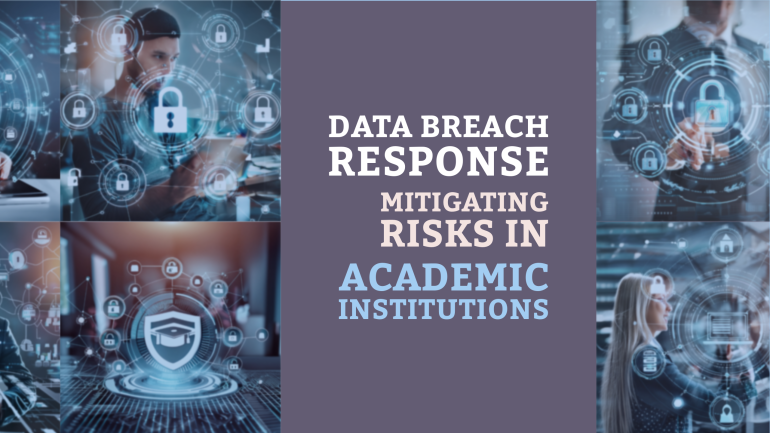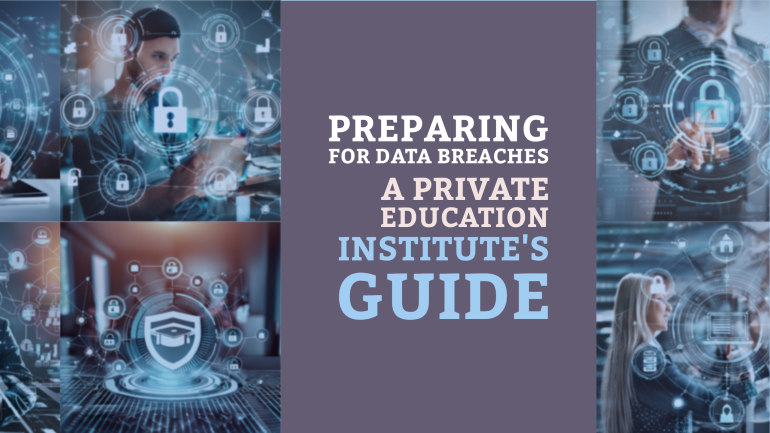This website uses cookies so that we can provide you with the best user experience possible. Cookie information is stored in your browser and performs functions such as recognising you when you return to our website and helping our team to understand which sections of the website you find most interesting and useful.
Table of Contents
You may also interested:
TL;DR: Crafting an Effective Data Breach Management Plan for Universities
- Proactive Approach: Universities should take a proactive approach to data breach management by developing a comprehensive plan before an incident occurs.
- Clear Communication: Clear lines of communication and roles should be established in the data breach management plan to ensure a coordinated response.
- Training and Education: Regular training and education on data privacy and security measures are crucial to equip staff with the knowledge to prevent and respond to breaches.
- Legal Compliance: Universities must ensure that their data breach management plan aligns with legal requirements such as GDPR or HIPAA to avoid potential fines and reputational damage.
- Testing and Improvement: Regular testing, drills, and evaluations of the data breach management plan are crucial to identify weaknesses and areas for improvement.
Many universities store vast amounts of sensitive data, making them prime targets for cyber-attacks. With the repercussions of data breaches ranging from financial losses to damaged reputation, having a comprehensive data breach management plan is crucial. This blog post will highlight the key components that universities should consider when creating an effective plan to protect their data and respond swiftly and efficiently in the event of a breach.
Understanding Data Breaches
Common Causes of Data Breaches in Universities
Understanding the common causes of data breaches in universities is crucial for developing a robust data breach management plan. Assuming internal factors such as human error or negligence, inadequate security measures, outdated software, and external factors like cyberattacks or malware can lead to data breaches. It is imperative for universities to proactively address these vulnerabilities to mitigate the risks of a data breach.
The Impact of Data Breaches on Educational Institutions
Educational institutions are prime targets for cybercriminals due to the sensitive student and staff information they possess. Understanding the impact of data breaches on educational institutions is vital. Not only can data breaches result in financial losses, reputational damage, and legal consequences, but they can also jeopardize the trust and security of the entire academic community.
A data breach can have far-reaching consequences for an educational institution, affecting not only its operations but also its relationships with students, faculty, and stakeholders. Additionally, the potential loss of sensitive data such as student records, research findings, or intellectual property can significantly hinder the institution’s ability to function effectively.
Developing a Data Breach Management Plan
Establishing a Data Breach Response Team
Even the most comprehensive security measures cannot guarantee immunity from data breaches. Therefore, it is necessary for universities to establish a specialized Data Breach Response Team. This team should consist of individuals from various departments including IT, legal, communications, and senior management to ensure a swift and coordinated response in the event of a breach.
Identifying and Classifying University Data Assets
Plan to identify and classify university data assets is crucial in developing a robust data breach management plan. This involves conducting a thorough inventory of all data collected, stored, and processed by the university and categorizing them based on sensitivity and criticality. By understanding the importance of each data asset, universities can prioritize their protection efforts.
Plus, regular updates to the data inventory and classification system are necessary to adapt to changes in data usage and storage practices over time. By consistently reviewing and updating this information, universities can ensure that their data breach management plan remains relevant and effective in safeguarding sensitive information.
Data Breach Response Strategies
Immediate Response Actions Following a Data Breach
Breach: In the immediate aftermath of a data breach at a university, rapid response is crucial. The first step is to contain the breach by isolating the affected systems and networks to prevent further data loss. Simultaneously, the university should notify the appropriate authorities and establish a response team to investigate the breach thoroughly.
Long-Term Recovery and Prevention Measures
Following a data breach, it is important for universities to implement comprehensive long-term recovery and prevention measures. This includes conducting a thorough post-incident analysis to identify vulnerabilities and weaknesses in the current security infrastructure and addressing them promptly. Additionally, universities should enhance their cybersecurity protocols, provide regular training to staff and students on data security best practices, and regularly review and update their data breach response plan.
Recovery: Implementing strong long-term recovery and prevention measures is crucial to not only recover from a data breach but also to prevent future incidents. By taking these proactive steps, universities can safeguard sensitive information, maintain their reputation, and instill trust among stakeholders.
Training and Awareness
Incorporating Data Security into University Curriculum
Many universities are recognizing the critical importance of incorporating data security principles into their curriculum to better equip students with the necessary knowledge and skills to protect sensitive information. By integrating topics such as cybersecurity, data privacy laws, and best practices for handling data into various courses across disciplines, universities can ensure that graduates are well-versed in data protection measures.
Regular Training Sessions for Staff and Students
Students and staff members alike must undergo regular training sessions to stay updated on the latest cybersecurity threats and protocols. These sessions help in creating a culture of awareness and responsibility towards data security within the university community. Regular training ensures that everyone understands their roles and responsibilities in safeguarding sensitive information, ultimately reducing the risk of a data breach.
Sessions should cover topics such as recognizing phishing emails, creating strong passwords, and securely storing data. By conducting frequent training sessions, universities can significantly mitigate the chances of a data breach occurring due to human error or negligence.
Legal and Regulatory Considerations
Understanding Compliance with Data Protection Laws
Not having a comprehensive understanding of compliance with data protection laws can expose universities to significant legal and financial risks. It is imperative for university administrators to stay informed about applicable regulations such as the General Data Protection Regulation (GDPR) and the Family Educational Rights and Privacy Act (FERPA) to ensure the protection of student and staff data.
Reporting Obligations and Communication Protocols
Data breach incidents must be handled promptly and efficiently to comply with reporting obligations and communication protocols. Obligations may vary depending on the nature and scope of the breach, but universities must prioritize notifying affected individuals, regulatory authorities, and other relevant stakeholders. Establishing clear communication protocols in advance can streamline the response process and help mitigate potential damages.
Technological Solutions
Utilizing Security Software and Monitoring Tools
Once again, when developing a data breach management plan for universities, employing robust security software and monitoring tools is crucial. These tools can actively track network activity, identify potential vulnerabilities, and provide real-time alerts for any suspicious behavior.
Leveraging Encryption and Access Control Systems
Tools like encryption and access control systems are paramount in safeguarding sensitive data within universities. Encryption scrambles data so that it is unreadable without the correct decryption key, making it a critical defense against unauthorized access. Access control systems dictate who can view and interact with specific information, ensuring that only authorized personnel can access sensitive data.
Access control systems are particularly imperative in higher education institutions where various departments and personnel have access to a wide range of sensitive information. By implementing granular access controls, universities can limit exposure to data breaches and protect their valuable assets.
Considering all points
Crafting an effective data breach management plan for universities is crucial in today’s digital age. By prioritizing prevention, detection, response, and recovery strategies, universities can better protect their sensitive data and mitigate the potential damages of a breach. Regular risk assessments, staff training, and clear communication protocols are key components of a robust data breach management plan. It is necessary for universities to stay proactive, continually update their plans, and collaborate with relevant stakeholders to ensure a swift and efficient response to any security incidents. With the right resources and strategies in place, universities can safeguard their reputation, finances, and most importantly, the privacy and security of their students and staff.
FAQ
Q: What is a data breach management plan for universities?
A: A data breach management plan for universities is a comprehensive strategy that outlines procedures and protocols to prevent, detect, respond to, and recover from data breaches that may compromise sensitive information within a university’s systems.
Q: Why is it important for universities to have a data breach management plan?
A: Universities deal with large amounts of sensitive data, including student records, research data, and financial information. A data breach management plan is crucial for universities to protect this information and maintain trust with students, staff, and stakeholders.
Q: What should be included in a data breach management plan for universities?
A: A data breach management plan for universities should include procedures for risk assessment, incident response, communication protocols, data recovery strategies, legal compliance requirements, and staff training on data security best practices.
Q: How can universities prevent data breaches?
A: Universities can prevent data breaches by implementing robust cybersecurity measures, such as encryption, access controls, network monitoring, regular software updates, employee training programs, and conducting security audits and assessments.
Q: What steps should universities take in the event of a data breach?
A: In the event of a data breach, universities should follow their data breach management plan, which typically involves containing the breach, assessing the scope of the incident, notifying affected individuals, coordinating with law enforcement and regulatory authorities, implementing corrective measures, and conducting a post-incident review to prevent future breaches.





